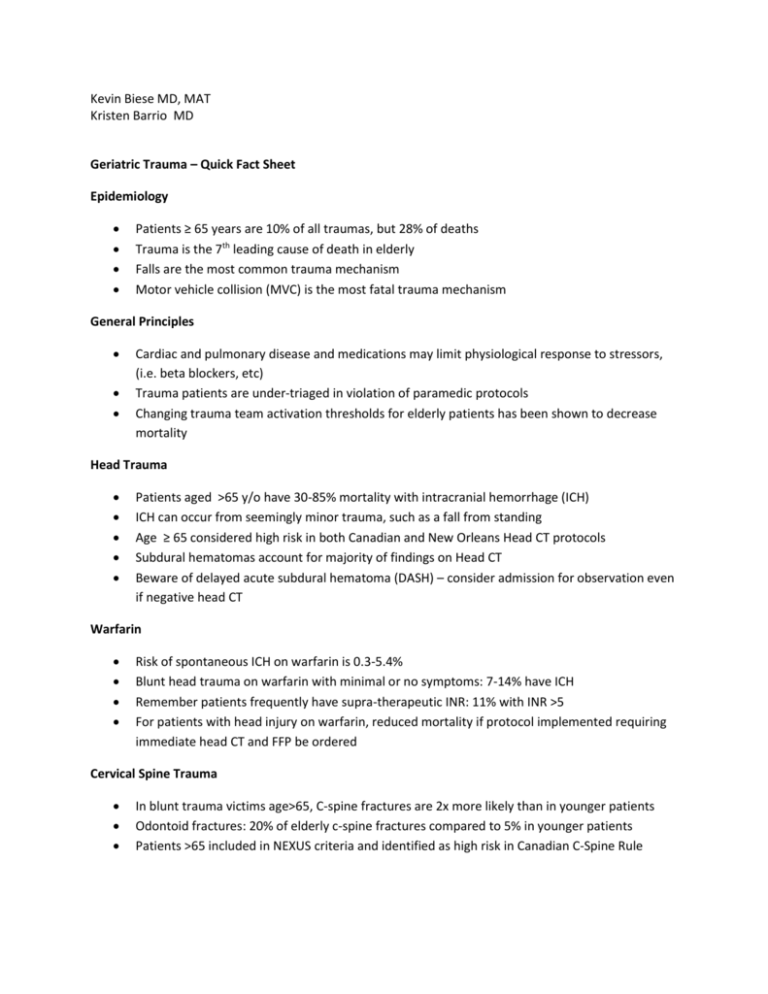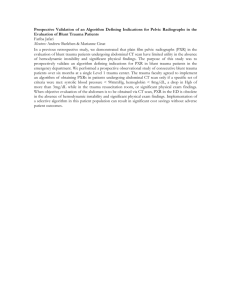Geriatric Trauma
advertisement

Kevin Biese MD, MAT Kristen Barrio MD Geriatric Trauma – Quick Fact Sheet Epidemiology Patients ≥ 65 years are 10% of all traumas, but 28% of deaths Trauma is the 7th leading cause of death in elderly Falls are the most common trauma mechanism Motor vehicle collision (MVC) is the most fatal trauma mechanism General Principles Cardiac and pulmonary disease and medications may limit physiological response to stressors, (i.e. beta blockers, etc) Trauma patients are under-triaged in violation of paramedic protocols Changing trauma team activation thresholds for elderly patients has been shown to decrease mortality Head Trauma Patients aged >65 y/o have 30-85% mortality with intracranial hemorrhage (ICH) ICH can occur from seemingly minor trauma, such as a fall from standing Age ≥ 65 considered high risk in both Canadian and New Orleans Head CT protocols Subdural hematomas account for majority of findings on Head CT Beware of delayed acute subdural hematoma (DASH) – consider admission for observation even if negative head CT Warfarin Risk of spontaneous ICH on warfarin is 0.3-5.4% Blunt head trauma on warfarin with minimal or no symptoms: 7-14% have ICH Remember patients frequently have supra-therapeutic INR: 11% with INR >5 For patients with head injury on warfarin, reduced mortality if protocol implemented requiring immediate head CT and FFP be ordered Cervical Spine Trauma In blunt trauma victims age>65, C-spine fractures are 2x more likely than in younger patients Odontoid fractures: 20% of elderly c-spine fractures compared to 5% in younger patients Patients >65 included in NEXUS criteria and identified as high risk in Canadian C-Spine Rule Chest Trauma In elderly patients with isolated thoracic injuries, mortality of patients >65 was 15% If patient has 3 or more rib fractures mortality was > 30% Most mortality subsequent to pneumonia Pelvic Trauma In pelvic fractures, elderly patients have high rates of hemorrhage, transfusion, and ICU admission even with a benign fracture pattern (lateral compression) There is some evidence that early angiographic embolization is helpful in elderly patients with pelvic trauma Hip fractures have 15-20% mortality rate within the first year. Between 25-50% of patients will not regain the ability to ambulate Burn Injuries Elderly patients represent 1/5 of all burn unit admissions Traditional mortality estimate is age + %burn References Bergeron et al. Elderly trauma patients with rib fractures are at greater risk of death and pneumonia. J of Trauma 2003; 54: 478-85. Callaway, Wolfe. Geriatric Trauma. Emerg Med Clin 2007; 25: 837-860. Demetriades et al. Effect on outcome of early intensive management of geriatric trauma patients. Brit J Surg 2002; 89: 1319-1322. Demetriades et al. Old age as a criterion for trauma team activation. J Trauma 2001; 51: 754-7. Hylek et al. Major hemorrhage and tolerability of warfarin in the first year of therapy among elderly patients with atrial fibrillation. Circulation AHA 2007; 115: 2689-2696 Ivascu et al. Rapid warfarin reversal in anticoagulated patients with traumatic intracranial hemorrhage reduces hemorrhage progression and mortality. J Trauma 2005; 59: 11311139. Kimbrell et al Angiographic embolization for pelvic fractures in older patients. Arch Surg 2004; 139: 728-733. Ma et al. Compliance with prehospital triage protocols for major trauma patients. J Trauma. 1999 Jan; 46(1) 168-75. Meldon S, Ma O., Woolard R. Geriatric Emergency Medicine. McGraw Hill, 2004. Touger et al. Validity of a decision rule to reduce cervical spine radiography in elderly patients with blunt trauma. Ann Emerg Med. 2002 Sep; 40(3): 287-93.









